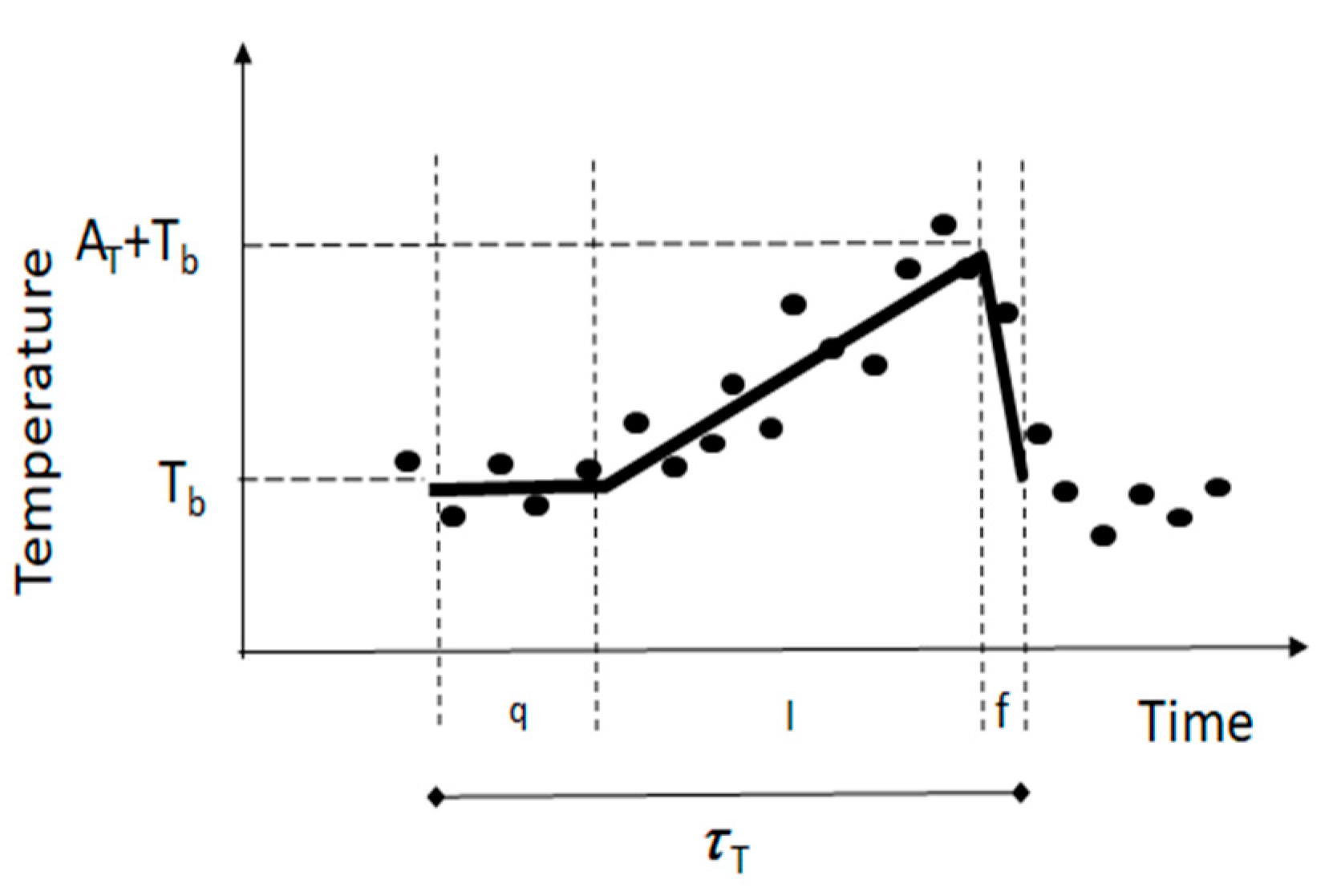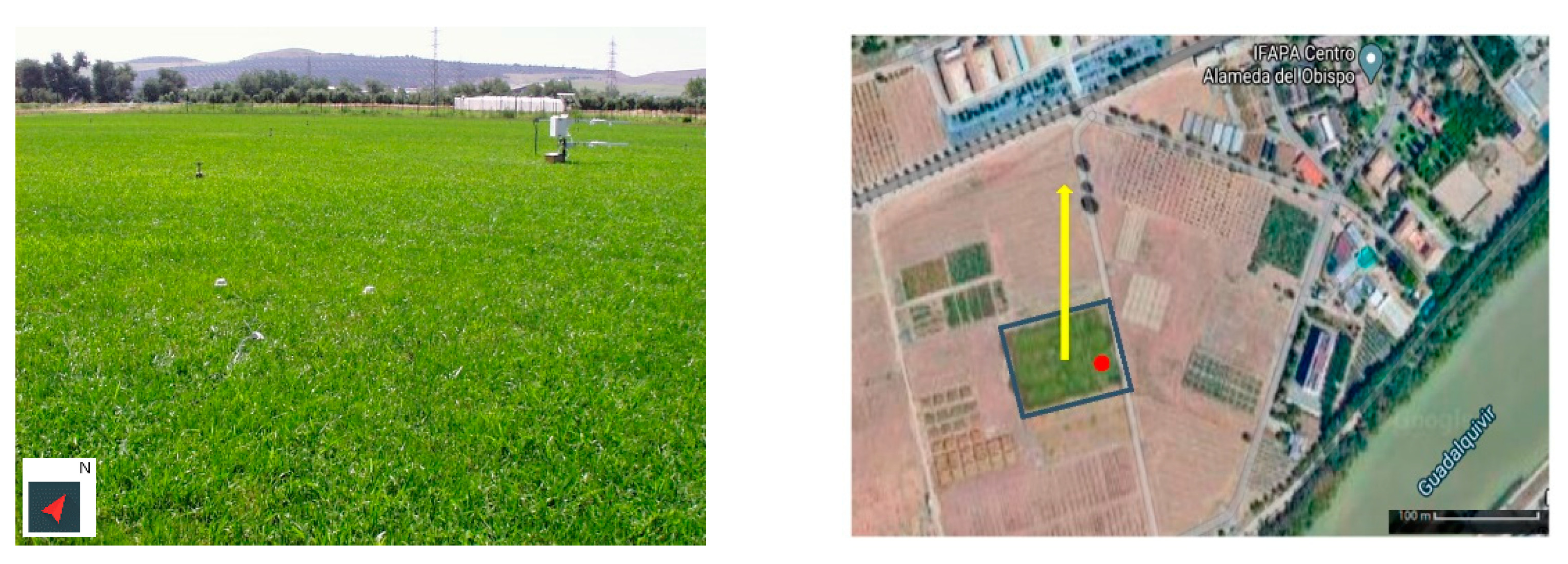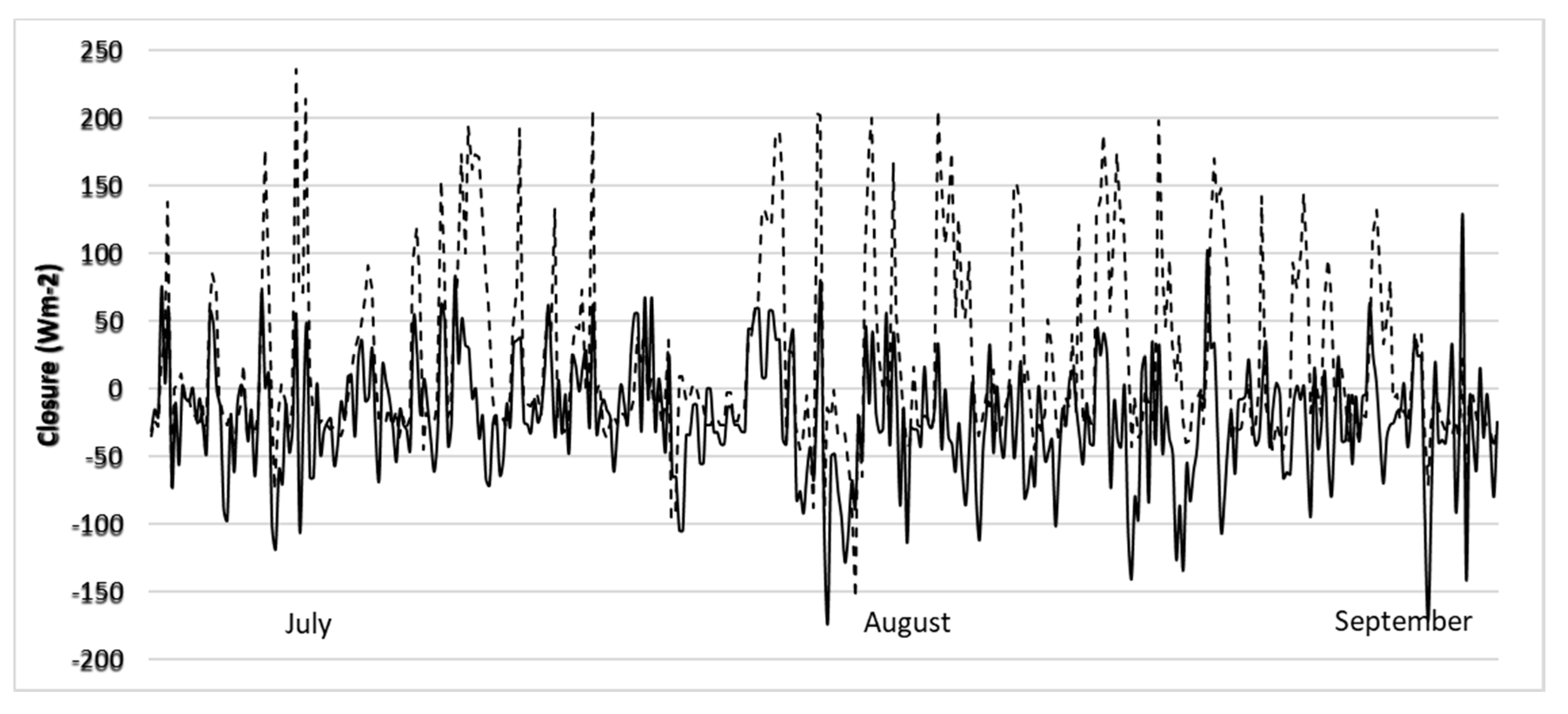Estimation of the Latent Heat Flux over Irrigated Short Fescue Grass for Different Fetches
Abstract
1. Introduction
2. Theory
2.1. The SR-P Method
2.2. The SR-D Method
3. Materials and Methods
3.1. The Site and Climate
3.2. Experimental Set Up
3.3. Dataset
3.4. Flux Estimates
3.5. Procedure for Comparison
4. Results
5. Discussion
Author Contributions
Funding
Institutional Review Board Statement
Informed Consent Statement
Data Availability Statement
Conflicts of Interest
Appendix A. The Surface Renewal Method to Estimate Surface Fluxes

References
- Brutsaert, W. Evaporation into the Atmosphere; D. Reidel Publishing Company: Dordrecht, The Netherlands, 1982. [Google Scholar]
- Brunet, Y. Turbulent Flow in Plant Canopies: Historical Perspective and Overview. Bound. Layer Meteorol. 2020, 315–364. [Google Scholar] [CrossRef]
- Cuxart, J.; Boone, A.A. Evapotranspiration over Land from a Boundary-Layer Meteorology Perspective. Bound. Layer Meteorol. 2020, 427–459. [Google Scholar] [CrossRef]
- Shuttleworth, W.J. Putting the vap into evaporation. Hydrol. Earth Syst. Sci. 2007, 11, 210–244. [Google Scholar] [CrossRef]
- Foken, T. Micrometeorology; Springer: Berlin/Heidelberg, Germany, 2008. [Google Scholar]
- Twine, T.E.; Kustas, W.P.; Norman, J.M.; Cook, D.R.; Houser, P.R.; Meyers, T.P.; Prueger, J.H.; Starks, P.J.; Wesely, M.L. Correcting eddy-covariance flux underestimates over a grassland. Agric. Forest Meteorol. 2000, 103, 279–300. [Google Scholar] [CrossRef]
- Pereira, L.S.; Allen, R.G.; Smith, M.; Raes, D. Crop evapotranspiration estimation with FAO56: Past and future. Agric. Water Manag. 2015, 147, 4–20. [Google Scholar] [CrossRef]
- de Bruin, H.A.R.; Trigo, I.F.; Bosveld, F.C.; Meirink, J.F. A thermodynamically based model for actual evapotranspiration of an extensive grass field close to FAO Reference, suitable for remote sensing application. J. Hydrometeorol. 2016, 17, 1373–1382. [Google Scholar] [CrossRef]
- Castellví, F.; Medina, E.; Cavero, J. Surface eddy fluxes and friction velocity estimates taking measurements at the canopy top. Agric. Water Manag. 2020, 241, 106358. [Google Scholar] [CrossRef]
- Castellví, F.; Suvočarev, K.; Reba, M.; Runkle, B. A new free-convection form to estimate sensible heat and latent heat fluxes for unstable cases. J. Hydrol. 2020, 586, 124917. [Google Scholar] [CrossRef]
- Stull, R.B. An Introduction to Boundary Layer Meteorology; Atmospheric and Oceanographic Sciences Library; Springer: Cham, Switzerland, 1988. [Google Scholar]
- Graefe, J. Roughness layer corrections with emphasis on SVAT model applications. Agric. For. Meteorol. 2004, 124, 237–251. [Google Scholar] [CrossRef]
- Horst, T.W.; Weill, J.C. How far is far enough?: The fetch requirements for micrometeorological measurement of surface fluxes. J. Atmos. Ocean. Technol. 1994, 11, 1018–1025. [Google Scholar] [CrossRef]
- Castellví, F. Fetch requirements using surface renewal analysis for estimating scalar surface fluxes from measurements in the inertial sublayer. Agric. Forest Meteorol. 2012, 152, 233–239. [Google Scholar] [CrossRef]
- Burba, G.; Anderson, D. Introduction to the Eddy Covariance Method: General Guidelines and Conventional Workflow; LI-COR Biosciences: Lincoln, NE, USA, 2007; 141p, ISBN 1951D438-A0374350-AA92950EFF6457. [Google Scholar] [CrossRef]
- Aubinet, M.; Vesala, T.; Papale, D. Eddy Covariance: A Practical Guide to Measurement and Data Analysis; Springer: Berlin/Heidelberg, Germany, 2012. [Google Scholar]
- Noltz, R.; Krammerer, G.; Cepuder, P. Interpretation of lysimeter weighing data affected by wind. J. Plant Nutr. Soil Sci. 2013, 176, 200–208. [Google Scholar] [CrossRef]
- Silva, J.C.; Silva, T.J.A.; Bonfim-Silva, E.M.; Duarte, T.F.; Pacheco, A.B. Construction and assessment of a hydraulic weighing lysimeter. Afr. J. Agric. Res. 2016, 11, 951–960. [Google Scholar]
- Haymann, N.; Lukyanova, V.; Tanny, J. Effects of variable fetch and footprint on surface renewal measurements of sensible and latent heat fluxes in cotton. Agric. For. Meteorol. 2019, 124, 237–251. [Google Scholar] [CrossRef]
- Jegede, O.O.; Foken, T. A study of the internal boundary layer due to a roughness change in neutral conditions observed during the LINEX field campaigns. Theor. Appl. Climatol. 1999, 62, 31–41. [Google Scholar] [CrossRef]
- Levy, P.; Drewera, J.; Jammeta, M.; Leeson, S.; Friborgb, T.; Skibaa, U.; Van Oijena, M. Inference of spatial heterogeneity in surface fluxes from eddy covariance data: A case study from a subarctic mire ecosystem. Agric. For. Meteorol. 2020, 280, 107783. [Google Scholar] [CrossRef]
- Castellví, F. Combining surface renewal analysis and similarity theory: A new approach for estimating sensible heat flux. Water Resour. Res. 2004, 40, W05201. [Google Scholar] [CrossRef]
- Castellvi, F.; Snyder, R.L. Combining the dissipation method and surface renewal analysis to estimate scalar fluxes from the time traces over rangeland grass near Ione (California). Hydrol. Process. 2009, 23, 842–857. [Google Scholar] [CrossRef]
- Kustas, W.P.; Norman, J.M. Evaluation of soil and vegetation heat flux predictions using a simple two-source model with radiometric temperatures for partial canopy cover. Agric. For. Meteorol. 1999, 94, 13–29. [Google Scholar] [CrossRef]
- Jiang, L.; Islam, S.; Carlson, T.R. Uncertainties in latent heat flux measurement and estimation: Implications for using a simplified approach with remote sensing data. Can. J. Rem. Sens. 2004, 30, 769–787. [Google Scholar] [CrossRef]
- Bisht, G.; Venturini, V.; Islam, S.; Jiang, L. Estimation of the net radiation using MODIS (Moderate Resolution Imaging Spectroradiometer) data for clear sky days. Remote Sens. Environ. 2005, 97, 52–67. [Google Scholar] [CrossRef]
- Hu, Y.; Buttar, N.A.; Tanny, J.; Snyder, R.L.; Savage, M.J.; Lakhiar, I.A. Surface renewal application for estimating evapotranspiration: A review. Adv. Meteorol. 2018, 1690714. [Google Scholar] [CrossRef]
- Högström, U. Review of some basic characteristics of the atmospheric surface layer. Bound. Layer Meteorol. 1996, 78, 215–246. [Google Scholar] [CrossRef]
- Higbie, R. The rate of absorption of a pure gas into a still liquid during short periods of exposure. Trans. AIChE 1935, 31, 365–388. [Google Scholar]
- Paw, U.K.T.; Qiu, J.; Su, H.B.; Watanabe, T.; Brunet, Y. Surface renewal analysis: A new method to obtain scalar fluxes without velocity data. Agric. Forest Meteorol. 1995, 74, 119–137. [Google Scholar]
- Chen, W.; Novak, M.D.; Black, T.A.; Lee, X. Coherent eddies and temperature structure functions for three contrasting surfaces. Part I: Ramp model with finite micro-front time. Bound. Layer Meteorol. 1997, 84, 99–123. [Google Scholar] [CrossRef]
- Castellví, F. A method for estimating the sensible heat flux in the inertial sub-layer from high-frequency air temperature and averaged gradient measurements. Agric. Forest Meteorol. 2013, 180, 68–75. [Google Scholar] [CrossRef]
- Dyer, A.J. A review of flux-profile relationships. Bound. Layer Meteorol. 1974, 363–372. [Google Scholar] [CrossRef]
- Panofsky, H.; Dutton, J. Atmospheric Turbulence: Models and Methods for Engineering Applications; John Wiley: New York, NY, USA, 1984. [Google Scholar]
- Pahlow, M.; Parlange, M.B.; Port’e-Agel, F. On Monin-Obukhov similarity in the stable atmospheric boundary layer. Bound. Layer Meteorol. 2001, 99, 225–248. [Google Scholar] [CrossRef]
- Hartogensis, O.K.; de Bruin, H.A.R. Monin-Obukhov similarity function of the structure parameter of temperature and turbulent kinetic energy dissipation rate in the stable boundary layer. Bound. Layer Meteorol. 2005, 116, 253–276. [Google Scholar] [CrossRef]
- Champagne, F.H.; Friehe, C.A.; Larue, J.C. Flux measurements, flux estimation techniques, and Fine-Scale turbulence measurements in the unstable surface layer over land. J. Atmos. Sci. 1977, 34, 515–530. [Google Scholar] [CrossRef]
- Antonia, R.A.; Chambers, A.J.; Friehe, C.A.; Van Atta, C.W. Temperature ramps in the atmospheric surface layer. J. Atmos. Sci. 1979, 36, 99–108. [Google Scholar] [CrossRef]
- Bradley, E.R.; Antonia, R.A.; Chambers, A.J. Temperature structure in the atmospheric surface layer. Bound. Layer Meteorol. 1981, 20, 275–292. [Google Scholar] [CrossRef]
- Kader, B.A. Determination of turbulent momentum and heat fluxes by spectral methods. Bound. Layer Meteorol. 1992, 61, 323–347. [Google Scholar] [CrossRef]
- Kiely, G.; Albertson, J.D.; Parlange, M.B.; Eichinger, W.E. Convective scaling of the average dissipation rate of tempearture variance in the atmospheric surface layer. Bound. Layer Meteorol. 1996, 77, 267–284. [Google Scholar] [CrossRef]
- Hsieh, C.I.; Katul, G.G.; Schieldge, J.; Sigmon, J.; Knoer, K.R. Estimation of momentum and heat fluxes using dissipation and flux-variance methods in the unstable surface layer. Water Resour. Res. 1996, 32, 2453–2462. [Google Scholar] [CrossRef]
- Hsieh, C.I.; Katul, G.G. Dissipation methods, Taylor’s hypothesis, and stability correction functions in the atmospheric surface layer. J. Geophys. Res. 1997, 102, 16391–16405. [Google Scholar] [CrossRef]
- Hernández-Ceballos, M.A.; Adame, J.A.; Bolívar, J.P.; De la Morena, B.A. A mesoscale simulation of coastal circulation in the Guadalquivir valley (southwestern Iberian Peninsula) using the WRF-ARW model. Atmos. Res. 2013, 24, 1–20. [Google Scholar] [CrossRef]
- Berengena, J.; Gavilán, P. Reference evapotranspiration estimation in a highly advective semiarid environment. J. Irrig. Drain. Eng. 2005, 131, 147–163. [Google Scholar] [CrossRef]
- Gavilán, P.; Berengena, J. Accuracy of the Bowen ratio-energy balance method for measuring latent heat flux in a semiarid advective environment. Irrig. Sci. 2007, 25, 127–140. [Google Scholar] [CrossRef]
- Fuchs, M.; Tanner, C.B. Evaporation from a drying soil. J. Appl. Meteorol. 1967, 6, 852–857. [Google Scholar] [CrossRef]
- Sauer, T.J.; Horton, R. Soil heat flux. In Micrometeorology in Agricultural Systems ASA Monograph; Hatfield, J.L., Baker, J.M., Eds.; American Society of Agronomy: Madison, WI, USA, 2005; Chapter 7; Volume 47, pp. 131–154. [Google Scholar] [CrossRef]
- Horst, T.W.; Semmer, S.R.; Maclean, G. Correction of a non-orthogonal, three-component sonic anemometer for flow distortion by transducer shadowing. Bound. Layer Meteorol. 2015, 155, 371–395. [Google Scholar] [CrossRef]
- Mauder, M.; Foken, T. Documentation and Instruction Manual of the Eddy Covariance Software Package TK3 46; Abt. Mikrometeorologie, Arbeitsergebnisse; Universität Bayreuth: Bayreuth, Germany, 2011; p. 56. [Google Scholar]
- Mauder, M.; Oncley, S.P.; Vogt, R.; Weidinger, T.; Ribeiro, L.; Bernhofer, C.; Foken, T.; Kosiek, W.; de Bruin, H.A.R.; Liu, H. The energy balance experiment EBEX-2000. Part II: Intercomparison of eddy-covariance sensors and post-field data processing methods. Bound. Layer Meteorol. 2007, 123, 29–54. [Google Scholar] [CrossRef]
- Vickers, D.; Mahrt, L. The cospectral gap and turbulent flux calculations. J. Atmos. Ocenanic Technol. 2002, 20, 660–672. [Google Scholar] [CrossRef]
- Van de Wiel, B.J.H.; Moene, A.F.; Hartogensis, O.K.; de Bruin, H.A.R.; Holtslag, A.A.M. Intermittent turbulence in the stable boundary layer over land. Part III: A classification for observations during CASES-99. J. Atmos. Sci. 2003, 60, 2509–2522. [Google Scholar] [CrossRef]
- Steeneveld, G.J.; VandeWiel, B.J.H.; Holtslag, A.A.M. Modelling the evolution of the atmospheric boundary layer coupled to the land surface for a three day period in CASES-99. J. Atmos. Sci. 2006, 63, 920–935. [Google Scholar] [CrossRef]
- Burba, G. Eddy Covariance Method for Scientific, Industrial, Agricultural and Regulatory Applications; LiCor Biosciences: Lincoln, NE, USA, 2013. [Google Scholar]
- Van Atta, C.W. Effect of coherent structures on structure functions of temperature in the atmospheric boundary layer. Archit. Mech. 1977, 29, 161–171. [Google Scholar]
- Suvočarev, K.; Castellví, F.; Reba, M.L.; Runkle, B.R.K. Surface renewal measurements of H, λE and CO2 fluxes over two different agricultural systems. Agric. Forest Meteorol. 2019. [Google Scholar] [CrossRef]
- Castellví, F.; Snyder, R.L. A comparison between latent heat fluxes over grass using a weighing lysimeter and surface renewal analysis. J. Hydrol. 2010, 381, 213–220. [Google Scholar] [CrossRef]
- Katul, G.G.; Hsieh, C.I. A Note on the Flux-Variance Similarity Relationships for Heat and Water Vapour in the Unstable Atmospheric Surface Layer. Bound. Layer Meteorol. 1999, 90, 327–338. [Google Scholar] [CrossRef]
- Castellví, F.; Snyder, R.L.; Baldocchi, D.D. Surface energy-balance closure over rangeland grass using the eddy covariance method and surface renewal analysis. Agric. Forest Meteorol. 2008, 148, 1147–1160. [Google Scholar] [CrossRef]
- Horst, T.W. The footprint for estimation of atmosphere–surface exchange fluxes by profile techniques. Bound. Layer Meteorol. 1999, 90, 171–188. [Google Scholar] [CrossRef]
- Castellví, F. An advanced method based on surface renewal theory to estimate the friction velocity and the surface heat flux. Water Resour. Res. 2018, 54, 10134–10154. [Google Scholar] [CrossRef]
- Castellví, F.; Suvočarev, K.; Reba, M.; Runkle, B. Friction velocity estimates using the trace of a scalar and the mean wind speed. Bound. Layer Meteorol. 2020, 176, 105–123. [Google Scholar] [CrossRef]
- Kelley, J.; Higgins, C. Computational efficiency for the surface renewal method. Atmos. Meas. Tech. 2018, 11, 2151–2158. [Google Scholar] [CrossRef]
- Drexler, J.Z.; Snyder, R.L.; Spano, D.; Paw, U.K.T. A review of models and micrometeorological methods used to estimate wetland evapotranspiration. Hydrol. Process. 2004, 18, 2071–2101. [Google Scholar] [CrossRef]



| Daily Mean: | Tx | Tn | HRx | HRn | U | Rs | ET |
|---|---|---|---|---|---|---|---|
| (°C) | (°C) | (%) | (%) | (m/s) | (MJ/Day) | (mm/Day) | |
| Maximum | 39.9 | 23.2 | 85.6 | 34.6 | 3.3 | 32.3 | 9.2 |
| Minimum | 31.1 | 14.2 | 45.5 | 8.1 | 0.9 | 17.2 | 4.3 |
| Average | 35.8 | 19.0 | 66.5 | 15.9 | 1.9 | 27.8 | 7.2 |
| Dataset: N = 417 | 85% ≤ IFFP | ||||
|---|---|---|---|---|---|
| a | b | R2 | RMSE | RD | |
| Method: | (Wm−2) | (Wm−2) | |||
| LEEC | 0.71 | 3 | 0.96 | 73 | 0.73 |
| LESR-P | 0.85 | 6 | 0.91 | 60 | 0.9 |
| LESR-D | 0.9 | 25 | 0.77 | 93 | 1.07 |
| Rn − G − HEC | 1 | −22 | 0.95 | 48 | 0.86 |
| Rn − G − HSR-P | 0.96 | −23 | 0.95 | 52 | 0.81 |
| Rn − G − HSR-D | 0.96 | 15 | 0.88 | 70 | 1.07 |
| N = 749 | 75% < IFFP < 85% | ||||
| LEEC | 0.69 | 5 | 0.96 | 98 | 0.71 |
| LESR-P | 0.86 | 2 | 0.91 | 73 | 0.87 |
| LESR-D | 0.87 | 21 | 0.71 | 124 | 0.96 |
| Rn − G − HEC | 1 | −19 | 0.95 | 54 | 0.9 |
| Rn − G − HSR-P | 0.97 | −18 | 0.94 | 57 | 0.88 |
| Rn − G − HSR-D | 0.99 | 19 | 0.86 | 86 | 1.08 |
| N = 445 | 50% ≤ IFFP ≤ 75% | ||||
| LEEC | 0.52 | 5 | 0.83 | 133 | 0.55 |
| LESR-P | 0.55 | 3 | 0.9 | 125 | 0.56 |
| LESR-D | 0.6 | 9 | 0.71 | 136 | 0.64 |
| Rn − G − HEC | 1.05 | −5 | 0.94 | 51 | 1.02 |
| Rn − G − HSR-P | 0.99 | −7 | 0.94 | 49 | 0.95 |
| Rn − G − HSR-D | 1 | 3 | 0.92 | 55 | 1.01 |
| N = 1611 | 50% ≤ IFFP (all data) | ||||
| LEEC | 0.65 | 3 | 0.91 | 104 | 0.67 |
| LESR-P | 0.79 | 1 | 0.86 | 88 | 0.79 |
| LESR-D | 0.8 | 18 | 0.69 | 120 | 0.89 |
| Rn − G − HEC | 1.01 | −15 | 0.95 | 52 | 0.93 |
| Rn − G − HSR-P | 0.98 | −16 | 0.94 | 54 | 0.89 |
| Rn − G − HSR-D | 0.99 | 14 | 0.88 | 76 | 1.06 |
Publisher’s Note: MDPI stays neutral with regard to jurisdictional claims in published maps and institutional affiliations. |
© 2021 by the authors. Licensee MDPI, Basel, Switzerland. This article is an open access article distributed under the terms and conditions of the Creative Commons Attribution (CC BY) license (http://creativecommons.org/licenses/by/4.0/).
Share and Cite
Castellví, F.; Gavilán, P. Estimation of the Latent Heat Flux over Irrigated Short Fescue Grass for Different Fetches. Atmosphere 2021, 12, 322. https://doi.org/10.3390/atmos12030322
Castellví F, Gavilán P. Estimation of the Latent Heat Flux over Irrigated Short Fescue Grass for Different Fetches. Atmosphere. 2021; 12(3):322. https://doi.org/10.3390/atmos12030322
Chicago/Turabian StyleCastellví, Francesc, and Pedro Gavilán. 2021. "Estimation of the Latent Heat Flux over Irrigated Short Fescue Grass for Different Fetches" Atmosphere 12, no. 3: 322. https://doi.org/10.3390/atmos12030322
APA StyleCastellví, F., & Gavilán, P. (2021). Estimation of the Latent Heat Flux over Irrigated Short Fescue Grass for Different Fetches. Atmosphere, 12(3), 322. https://doi.org/10.3390/atmos12030322






